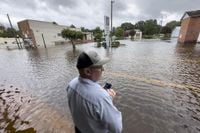September 2025 will be remembered in the Northern Plains for weather that was anything but ordinary—an unpredictable mix of record-breaking tornadoes, wild temperature swings, and rainfall extremes that kept meteorologists and residents alike on their toes. From the high mountains of Colorado to the rolling prairies of North Dakota and neighboring states, the month delivered both chaos and relief, etching itself into the region’s climatological history.
Let’s start in Colorado, where, as reported by Meteorologist Dylan Kikuta, a storm in September set a new record for the highest elevation at which a tornado has ever been recorded in the state. Mountain tornadoes are rare, and this event caught the attention of weather watchers across the country. While details about the exact location and elevation are still being finalized, the fact remains: Colorado’s wild weather this September shattered what many thought possible when it comes to tornado activity in the Rockies.
But if Colorado’s high-altitude twister was remarkable, North Dakota’s September was downright historic. According to KXNET, on September 14, a staggering 20 tornadoes touched down across a narrow corridor of central North Dakota. This wasn’t just any outbreak: it obliterated the previous September tornado count for the state and came within a hair’s breadth of breaking North Dakota’s all-time single-day tornado record of 24, which had stood since June 1976.
What made this outbreak particularly unusual was the timing. Tornadoes in September are rare in North Dakota, which typically sees its most severe storms during the late spring and early summer. Yet, the 2025 severe weather season refused to follow the rules. The majority of these tornadoes were unrated, simply because they didn’t cause enough damage for strength estimates to be assigned. Of those that did leave a mark, two were rated EF2, packing wind speeds in excess of 100 miles per hour. Miraculously, despite the power and number of these tornadoes, there were no reported injuries.
For many in North Dakota, this outbreak was just the final act in a severe weather season that had already delivered a derecho, numerous hailstorms, and a grand total of 80 tornadoes across the state. Such a chaotic stretch of weather, spanning months, left meteorologists marveling—and residents a bit weary.
Yet, even amid the tumult, there was good news. As KXNET highlighted, by the end of September, North Dakota achieved something it hadn’t seen in three years: a completely empty Drought Monitor map. Not a single patch of dryness remained across the state, making North Dakota the only state in the lower 48 with 0% dryness. This was a remarkable turnaround for a region that, not so long ago, had been grappling with persistent drought.
The rainfall that banished the drought didn’t fall evenly, however. Some areas received more than double their usual September precipitation, especially during a wet stretch in the middle of the month. Mobridge, South Dakota, just across the border, logged over 6 inches of rain—by far its wettest September since records began in 1911. In contrast, the western half of the region told a different story. Dickinson, North Dakota, notched its 7th driest September on record, with rainfall totals failing to reach even a quarter of an inch. Such stark contrasts, from deluge to drought within a few hundred miles, are a hallmark of the region’s unpredictable climate.
Temperature swings added another layer of complexity. September 2025 was warmer than normal for much of the region, with several stretches of comfortably toasty weather. Many locations saw at least one day with a high near or above 90°F. Wolf Point, Montana, took the crown as the region’s hotspot, reaching a sizzling 92°F on September 1. Dickinson, North Dakota, recorded its 5th warmest September ever, while Williston, Minot, and Bismarck all cracked their respective top-10 warmest marks for the month. The summerlike weather lingered right up until the final days of September, with a string of 80-degree highs keeping autumn at bay.
But the warmth was punctuated by some truly chilly mornings. The coolest temperatures of the month arrived early, during the first week of September. Dickinson experienced its earliest first freeze in over fifty years on September 6, when the mercury dropped to 30°F. Hettinger, not to be outdone, plunged all the way to 26°F that same morning, earning the dubious distinction of being the coldest spot in the area for September. The rest of the region saw at least one morning with lows in the low to mid-30s, though Minot, Bismarck, and Williston had yet to experience their first freeze by month’s end.
With the days now shorter than the nights and average temperatures dropping fast, residents know that October will bring new weather challenges. The question on everyone’s mind, as KXNET playfully put it: “Will it snow? Will we get any more tornadoes?” The only certainty is that the region’s weather will keep everyone guessing.
For those keeping score, September 2025 managed to be both a capstone and a turning point. It capped off a severe weather season for the record books, with the state’s tornado tally reaching 80—an astonishing number for any year, let alone one capped by a September outbreak. Yet, it also marked a return to moisture and, for some, a break from the relentless dry spells of recent years. The Drought Monitor’s blank slate was a sight for sore eyes among farmers and ranchers, even as some watched nervously as fields turned soggy in places like Mobridge.
All told, September 2025 was a month that defied expectations at every turn. From the rarefied air of a Colorado mountain tornado to the tornado-laden skies of North Dakota, and from record rainfall to record warmth and cold, it was a month that showcased the full range of nature’s power and unpredictability. As the region moves into October, one thing’s for sure: the weather will be watched more closely than ever.
